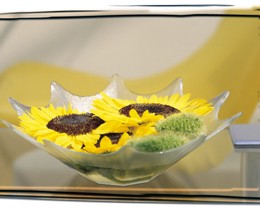
info about the flowers & plants association |
| the latest events in the flower world |
view the latest flower fashion trends |
green & gorgeous – boost your wellbeing with houseplants |
advice on where to buy & recommended retailers |
data & details about the flower industry |
how
to join and what benefits we can offer you as a member |
for
journalists & the media – what we can do for you |
index
of pages on this site to aid your navigation |
|
Sunflower
Name: The botanical
name is Helianthus. The Greek word "helios" means sun and "anthos"
means flower. It is aptly named after the sun which it resembles. Description: A large flower head with usually a big dark centre and bright yellow petals. Origin: South and West of the USA. Colour: Most sunflowers are bright yellow with dark brown centres, but varieties are appearing now which have tan, orange, maroon or striped petals, and green-yellow centres. Some are even without the central disc, but are fully covered in petals instead. Availability: A summer flower, but some are available all year round ('Orit') and most can be available from late spring to late autumn. Family: Asteraceae, Aster family Varieties: There are now so many varieties owing to its popularity and sunflower is one of the top ten best selling cut flowers in UK. 'Snittgold' cultivar, which is the classic sunflower, has more than 15 different varieties from the small-flowered 'Sonja' to the large-flowered 'Orit'. 'Sunrich Orange' has the darkest yellow of all the sunflower varieties. Other bi colours such as 'Prado Red' and 'Floristan' have reddish brown petals with yellow bordering. Care Tips: They need a lot of water. Trivia: Facts: Sunflower stems were used to fill lifejackets before the advent of modern materials. Low-pollen sunflowers have been developed in recent years which not only helps asthma sufferers, but extend the flower's life Language of Flowers: The dwarf sunflower means "adulation". Medicinal: The sunflower is grown for the seeds and oil it produces.Each mature flower yields 40% of its weight as oil. History: The flower was cultivated by North American Indians for many years as a food crop The nutritional value is still the main reason for growing it in many parts of the world. Only recently have we begun to grow sunflowers for decorative reasons. Zodiac: Sunflowers are bold and exuberant and one of the flower associated with the star sign Leo. .
| |
 |